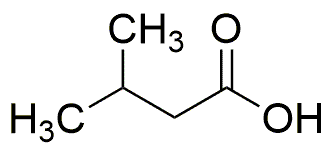Isovaleric acid is widely utilized in research focused on:
- Flavor and Fragrance Industry: This compound is used to create specific flavors and scents in food and cosmetic products, providing a unique profile that enhances consumer appeal.
- Pharmaceuticals: It serves as an intermediate in the synthesis of various pharmaceuticals, contributing to the development of medications that require complex organic compounds.
- Biochemical Research: Researchers use isovaleric acid to study metabolic pathways and its effects on biological systems, aiding in understanding diseases related to metabolism.
- Agriculture: The compound is utilized in the formulation of certain pesticides and herbicides, enhancing their effectiveness while being less harmful to the environment compared to traditional chemicals.
- Animal Nutrition: It is added to animal feed to improve digestion and nutrient absorption, promoting better growth rates and overall health in livestock.
General Information
Properties
Safety and Regulations
Applications
Isovaleric acid is widely utilized in research focused on:
- Flavor and Fragrance Industry: This compound is used to create specific flavors and scents in food and cosmetic products, providing a unique profile that enhances consumer appeal.
- Pharmaceuticals: It serves as an intermediate in the synthesis of various pharmaceuticals, contributing to the development of medications that require complex organic compounds.
- Biochemical Research: Researchers use isovaleric acid to study metabolic pathways and its effects on biological systems, aiding in understanding diseases related to metabolism.
- Agriculture: The compound is utilized in the formulation of certain pesticides and herbicides, enhancing their effectiveness while being less harmful to the environment compared to traditional chemicals.
- Animal Nutrition: It is added to animal feed to improve digestion and nutrient absorption, promoting better growth rates and overall health in livestock.
Documents
Safety Data Sheets (SDS)
The SDS provides comprehensive safety information on handling, storage, and disposal of the product.
Product Specification (PS)
The PS provides a comprehensive breakdown of the product’s properties, including chemical composition, physical state, purity, and storage requirements. It also details acceptable quality ranges and the product's intended applications.
Certificates of Analysis (COA)
Search for Certificates of Analysis (COA) by entering the products Lot Number. Lot and Batch Numbers can be found on a product’s label following the words ‘Lot’ or ‘Batch’.
*Catalog Number
*Lot Number
Certificates Of Origin (COO)
This COO confirms the country where the product was manufactured, and also details the materials and components used in it and whether it is derived from natural, synthetic, or other specific sources. This certificate may be required for customs, trade, and regulatory compliance.
*Catalog Number
*Lot Number
Safety Data Sheets (SDS)
The SDS provides comprehensive safety information on handling, storage, and disposal of the product.
DownloadProduct Specification (PS)
The PS provides a comprehensive breakdown of the product’s properties, including chemical composition, physical state, purity, and storage requirements. It also details acceptable quality ranges and the product's intended applications.
DownloadCertificates of Analysis (COA)
Search for Certificates of Analysis (COA) by entering the products Lot Number. Lot and Batch Numbers can be found on a product’s label following the words ‘Lot’ or ‘Batch’.
*Catalog Number
*Lot Number
Certificates Of Origin (COO)
This COO confirms the country where the product was manufactured, and also details the materials and components used in it and whether it is derived from natural, synthetic, or other specific sources. This certificate may be required for customs, trade, and regulatory compliance.


